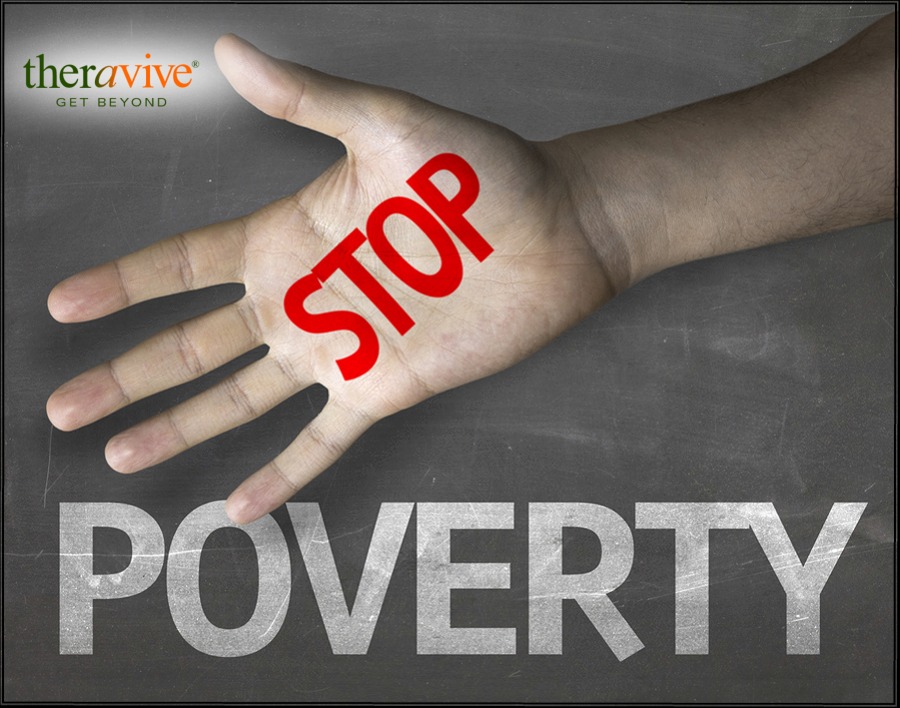
The United States of America. The land of the free. Equality for all. Fairness and justice. Americans routinely associate these phrases with this great country, but are they always true? Sadly, there is a trend in the United States today towards inequality, a widening of the income gap, and a tragic downslide towards poverty for millions of children in America today. The American dream is becoming just that: a dream, a whisper of hope that something could be different, even a figment of imagination for many of today’s children (“The American Dream”, 2014). This is even more true for children of color, for whom the gap is even wider (and continues to daily widen). Why is this? What are some of the contributing factors to childhood poverty? Who is at risk? What happens to children in poverty in America today? How do you recognize poverty in America? Below, learn some startling facts about childhood poverty and begin the first step: becoming educated about the difficult topic of childhood poverty in the United States today.
Half of All Children in United States Live Below Poverty Line
A recent article in Huffington Post outlined the devastating statistic that may shock a large amount of Americans: over half of America’s school-aged children live below the poverty line in the United States today, utilizing whether or not a family qualifies for free or reduced lunch as the standard measurement for poverty (“Children in poverty”, 2015). While the majority of the schools encompassing low-income families and children are in the Southern and Western regions of the United States, it is a growing problem for the entire country given the latest staggering statistics. That means out of every 10 children standing in a line, 5 of them live below the poverty line! Oftentimes, Americans speak about poverty as if it is some distant concept set apart (far away) in third world countries when the truth is, half of all American children are suffering every day here in the land of the free.
Many Low-Income Children Have No Opportunity to Attend Preschool
Due to disrupted family dynamics including younger mothers, single parents, and lower family incomes, many families are unable to afford quality preschool education for their children. This places children entering kindergarten at a disadvantage compared to their classmates who have already attended preschool and learned two years of concepts, words, and writing.
Many states have cut preschool programs that had typically been funded for its children, leaving thousands of children whose families are unable to provide preschool education for them affected. For example, since 2009, the state of Illinois has stopped providing preschool for 20,000 children, reducing the number from 90,000 to 70,000 served (“Nation’s youngest learners”, 2014). Further, there have also been studies questioning the quality of state sponsored preschool programs in states that do serve low-income families.
Children of Color Are Disproportionately Affected
Oftentimes, race and ethnicity is a difficult topic to discuss and it certainly must be done with a great deal of sensitivity. However, it must be addressed because Americans live in a multi-cultural country, and difficult topics such as poverty do not always affect each ethnicity fairly. Education is important to finding appropriate solutions and steps to overcoming such difficulties.
The Annie Casey Foundation conducts studies each year to analyze statistics of children in poverty in the United States by location, ethnicity, and year. There are over 16 million children who are reported to be living in poverty in America as of 2013. Hispanic children were disproportionately affected by poverty, with 5,717,000 living below the poverty line (“Children in poverty by ethnicity”, 2014).
Further, the Annie Casey Foundation found that 49 percent of African-American children lived in homes where parents did not have stable employment. Also, 67% of African-American children lived in single-parent homes, significantly above the national average of other ethnicities. Even though attendance rates for attending preschool were higher for African-American children, the Annie Casey Foundation found that either there were not enough programs available for these children, or the quality was lacking in the preschools that were actually made available to these children (“Nation’s youngest learners”, 2014). This is a direct correlation to the poverty these children are born into, of which they have no control over. Coupled with lack of education, how can these children expect to change the statistics?
Physical, Cognitive, & Emotional Effects of Poverty
Brooks-Gunn & Duncan discuss the health effects in detail as well as the correlation between child poverty and physical, emotional and mental health (Brooks-Gunn & Duncan, 1997). Poverty can negatively affect a child before he is even born, giving children above the poverty line a head start above low-income children before life outside the womb begins. Children born to low-income families often suffer malnutrition and as a result, are often born with low birth weight and the health difficulties that accompany low birth weight. Further, poor children had twice the possibility as children not classified as low income to be considered in fair or poor health, as opposed to excellent health. This could be correlated to many factors of environment, among which are sanitation of living situation, nutritional value of food, quality and quantity of food, exercise, education about sanitation, etc.
Further, the authors found a correlation between developmental delays, cognitive delays, grade repetition, school suspensions, high school dropout, emotional and behavioral problems, hunger, out of wedlock pregnancy, reported cases of child abuse and neglect, and future unemployment by age of 24 with childhood poverty. These issues can be life changing, negative circumstances that are being thrust upon the nation’s children as a result of poverty within their families.
Improving Access to Mental Health Services Could Decrease Effects of Poverty
Oftentimes, families encountering mental health difficulties (including behavioral, emotional and family crises) are not aware that help is readily available. Worse, sometimes help is not readily available due to lack of services, lack of funding, or other immediate issues. The World Health Organization states that mental health should be an integrated part of the health system, right alongside systems that treat physical health (“Mental health poverty”, 2015).
Battling a mental health disorder can feel debilitating on many different levels, and daily life can seem impossible. Obtaining and keeping a stable job can be difficult for parents in low-income families. Children, already entering school hungry and behind their peers educationally due to lack of services, can have severe difficulties with school, authority figures, and peers while battling mental disorders. Not only is it difficult to have any pleasure in normal activities, but daily life is impaired when one struggles with any type of mental or behavioral disorder. If these students and their families had appropriate access to mental health services, it is possible for other doors to open.
It is possible for the families to learn what services actually are available to them. It is possible for the children to have a person supporting them at their school and to learn about who could be part of their support network; sometimes, this makes all the difference in the life of a child from a low-income family. Sometimes, a child simply needs to learn how to appropriately advocate for himself in the school system and can learn this through his mental health counselor. It may sound like a small step, but it can mean a tremendously positive outcome for a child who has the odds stacked against him.
Professional Help is Available: Community Mental Health
If this article resonates with you as an individual affected by poverty and the accompanying mental health consequences whether as that individual, a parent, friend, or mental health professional seeking to make a difference, there are both public and private methods of assistance likely available to you in your area. Many States provide state-mandated agencies to meet the mental health needs of the communities in their areas. Whether the CSBs of Virginia or the MHMRAs of Texas, there are licensed and qualified mental health professionals available to assist. Further, there are private agencies providing drop-out prevention and case management support like the Communities in Schools program found within multiple school systems across the country at no-cost to families they serve. Of course the opportunity to create supports for your community is always available, but you may be surprised with how others in your community may already be working to help in ways you or your friends and family could benefit from or even how you could be a part of the organizations bringing about that change. Do your research and find those available clinical supports.
So YOU Want to Help? Be Tangible
It is so easy to get caught up in the overwhelming nature of a situation like this. It is also easy to forget about it, or to think, There’s nothing I can do to help. In fact, there are a lot of things you can do to help, regardless of age or socioeconomic status. The difficult thing is that it requires you to do something. Be tangible! For example, children from low-income families often are in need of school supplies. Go to your local school system and ask some of the teachers what kinds of school supplies they need for their classrooms. Many teachers find themselves purchasing supplies out their own pockets for their students. Gather some supplies yourself and drop them off, or organize a fill-a-backpack event with some of your friends. Help out at your local food pantry. Start a clothing drive and get connected with your local school, church, or soup kitchen for distribution of the clothes. Be creative. Most of all, be aware. With over half of all children in the United States living below the poverty line, statistics show that almost every day, you may run into a child or family who could use some kindness. (Couldn’t we all?) Whether it’s helping with school supplies or offering a smile and opening the door, be aware of your surroundings and the current demographic of the United States. Don’t just talk; be tangible, and help those around you with a positive attitude. If you happen to fall below the poverty line yourself and feel you may need some assistance, please don’t hesitate to research what resources are available in your local area and seek assistance for yourself and your family.
______________________________________________________________________________________________
References
Brooks-Gunn, J., and Duncan, G. (1997). The effects of poverty on children. Children a/nd Poverty. 7 (2), 55-71. Retrieved from https://www.princeton.edu/futureofchildren/publications/docs/07_02_03.pdf
Children in poverty by race and ethnicity. (2014, September). Retrieved from http://datacenter.kidscount.org/data/Bar/44-children-in-poverty-by-race-and-ethnicity?loc=1&loct=2#1/any/false/36/10,11,9,12,1,13,185/324
Increased poverty rate disproportionately impacts the nation’s youngest learners. (2014, August 15). Retrieved from http://www.huffingtonpost.com/2014/08/15/preschool-students-poverty_n_5680737.html
Mental health poverty and development. (2015). Retrieved from http://www.who.int/mental_health/policy/development/en/
More than half of American school children now live in poverty (2015, January 16). Retrieved from http://www.huffingtonpost.com/2015/01/16/southern-education-foundation-children-poverty_n_6489970.html
Price tag for the American dream: $130k per year. (2014, July 4). Retrieved from http://www.usatoday.com/story/money/personalfinance/2014/07/04/american-dream/11122015
About the Author

Trey and Rebecca Harrison
, LPC, CTTrey and Rebecca Harrison are professional counselors in Houston, Texas. They have been married since June 2007, and have established Revolution Counseling & Community Services together to provide hope and healing to children, adolescents and families through counseling, education, speaking, and writing.
Office Location:
5555 Morningside Dr, Suite 207F
Houston, Texas
77005
United States
Phone: 832-471-8780
Contact Trey and Rebecca Harrison